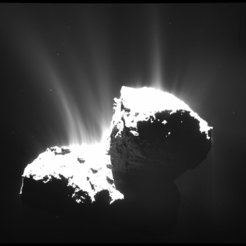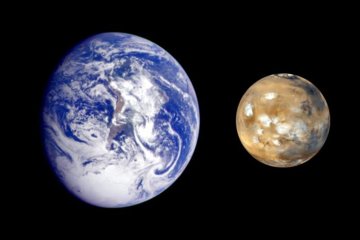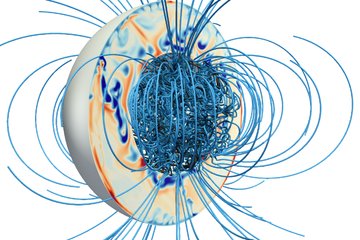Global distribution and dynamics of dust near comet 67P/Churyumov-Gerasimenko
Statistically analyse the large set of grain coma data in Rosetta/OSIRIS images of comet 67P/C-G
The European Space Agency's Rosetta mission visited comet 67P/Churyumov-Gerasimenko from 2014 to 2016. For the first time, scientists had the opportunity to monitor the evolution of a comet as it passed through perihelion. The mission returned an unprecedented data set which is still only superficially explored.
Rosetta has shown that the erosion and evolution of comets is strongly affected by their shape and obliquity. The goal of this project is to understand how dust activity is distributed across the surface of comet 67P and how this distribution is affected by changing illumination conditions. This will help to form a global picture of the activity of comet 67P, the relevant processes and the (sub-)surface properties of the comet.
The scientific camera system on board Rosetta, OSIRIS, ubiquitously observed individual pieces of debris, ranging from sub-millimetre dust grains to metre-sized chunks. Many images of the cometary "sky" remind of blowing snow on Earth, displaying either a multitude of bright points, or tracks of points stemming from particles moving in different apparent directions relative to the camera, or a combination thereof. These images show particles near the camera, and are therefore complementary to the measurements of the three dust detectors on board Rosetta.
The goal of this project is to statistically analyse the large set of grain coma data and interpret them through comparison with a numerical model of the dust flow from the comet. The relevant steps will be to
- develop an algorithm to derive relevant statistical properties of the imaging data,
- develop a code to simulate the motion of debris in the gravity field and a parameterised gas flow field of the comet,
- simulate artificial images of the cometary coma and derive their statistical properties in analogy to step 1,
- optimise the parameters characterising the physical properties of the dust emission (spatial and temporal distribution, velocity, particle size distribution) to best reproduce the data obtained in step 1 and from other Rosetta instruments.
The project requires solid programming skills and the ability to perceive the complex interplay of spacecraft and dust motion in the environment of the rotating comet. The project will be funded from an ERC Starting Grant to study activity in comets and asteroids.













